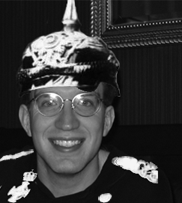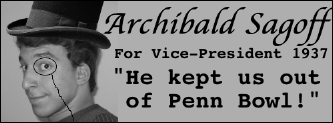The Pre-Modern Era of Chicago Quizbowl
The Pre-Modern Era of Chicago Quizbowl

Above: Adelmar von Hohenzollern, club founder.
The Early Years
While evidence of quizbowl dates back to the early medieval period, the history of quiz bowl at the University of Chicago dates back to 1917, when Prince Adelmar
Adalbert von Hohenzollern was hired by the University to teach core Social Science. A recent arrival
from Germany, Dr. von Hohenzollern quickly organized several student clubs, including College Bowl,
and developed a reputation as a fatherly man who would form personal relationships with students by
asking them what they knew about American military preparedness or shipping routes. Despite losing
Dr. von Hohenzollern during practice to spying charges in a 1918 Justice Department
raid of Cobb 106, the team flourished, and soon joined the Academic Competition Foederation,
the era's premier quiz bowling organization.
The Golden Era
To replace von Hohenzollern as coach, the University selected Matyas Litvak, a homeless Eastern European
immigrant who had been discovered peddling gloves along Stony Island. Despite the loss of several
players to the Spanish Flu, Litvak quickly pioneered the revolutionary "Triangle Offense", in which all
three players on a team would attempt to correctly ring in on as many tossups as they could. Chicago quickly rode this approach
to National Championships in 1919, 1921, and every year from 1923 to 1927 except for 1925, when they lost to a trained Chimpanzee named
Basileus, who many modern experts believe had prior access to the packet; others complained that a special rule allowing Basileus to signal using
finger paints was unfairly enforced. So successful was Coach Litvak that in 1928, the Academic Competition
Foederation moved from three-person to four-person teams, so that each team would "appropriately honor the contributions of Matyas Litvak to the sport, by having one
player for each of his four limbs."
The Call to Duty
As Chicago's prohibition-era violence escalated in the late 1920's, the U of C team developed a reputation
for being willing to play teams that "even the G-men are afraid to play." This reputation was put to the test
in the 1936 Academic Competition Foederation nationals. Believing that a win at ACF Nats would demonstrate Aryan racial superiority, Adolph Hitler
ordered several of his key henchmen to begin looking though old packets and memorizing clues that often appeared near the beginning of tossups. This allowed the
Germans to advance all the way to the final game that year, where they met Chicago A. Helped in part by Kannan Mahadevan and Chad Gerson, whom the Roosevelt administration, using a top-secret time machine,
had brought in from the future to ensure an American victory, Chicago A crushed a German team composed of Carl Schmitt, Rudolph Hess, Joachim von Ribbentrop, and Eva Braun, proving German quizbowl supremacy to be nothing
more than a political myth.

Above: Campaign Banner from an early officer election. Vice President Archibald Sagoff would later commit ritual suicide in 1940 after leading Chicago to its second consecutive Penn Bowl loss.
The Decline and Fall
After the death of Coach Litvak in 1940, the Chicago College Bowl Team entered one of its less-exciting periods. From 1941 to 1945, the Academic Competition Foederation
suspended all intercollegiate play, urging teams to donate their buzzers to the wartime scrap metal effort. Upon the 1946 resumption of play, the team was held back by the behavior of its newly-elected President,
Alban Berishaj, who many now suspect was a Communist infiltrator. Apart from bizarre proposals such as his 1948 effort to amend the ACF rules to include "Whenever Comrade Tito correctly buzzes in, he shall receive not 10 points, but 15", President
Berishaj was often observed withdrawing money from the team's account and leaving it in assorted hollowed fruits around campus, as well as routinely skipping practice to
seduce or blackmail members of the Physics department. Finally, in 1951, after an embarrassing neg at ACF Regionals (according to legend, he said "Golden Retriever" for "Bessemer Process" on the clue "Peter Cooper introduced this to the United States"), Bersishaj fled the country, reportedly settling in Yugoslavia. The team folded a year later, and the Academic Competition Foederation
soon followed, forced out of business by the newly-formed College Bowl, Incorporated company.
![]()